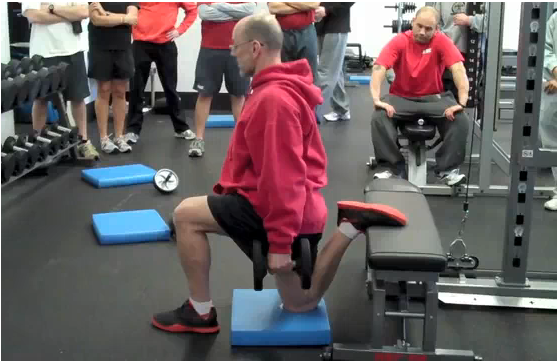Single Leg Training with Mike Boyle
“You do almost everything in sports in a split stance, or by pushing off one leg from a parallel stance, so it just makes sense to train your body that way” – Mike Boyle
I had the pleasure of meeting Mike Boyle at the Perform Better Seminar at the Parisi Speed School in Fair Lawn, NJ on 12/4. Fortunately, I had the opportunity to learn more about his hallmark single leg training protocol.
Coach Boyle started out by telling us that he has all of his athletes and clients start out by doing bilateral squats. Interestingly, he said, “Once you can squat right with 2 legs, I will never have you do it again. That is when we get into single leg work.”
Coach Boyle started us out with the Goblet squat, which he said that he learned about from another great strength coach, Dan John. He told us to hold a kettlebell with the horns down, like a goblet, as if you were going to drink from it.
The progressions were:
1) Bilateral Goblet Squat
2) Single Leg Reverse Lunge (KB in Goblet position)
3) Split Squat, (KB in Goblet position)
4) Rear Foot Elevated Split Squat (KB in Goblet position)
Coach Boyle also showed us the Reverse Slide Lunge and the Reach out hip extension.
When he finished, I asked him if the goal were maximum hypertrophy, would he still advocate single leg work and he said, “Of course, for overall leg development, single leg work is superior.”
Let’s dig a bit deeper…
What is the weakest link in doing a standard barbell bilateral back squat?
A: Your Back.
How do you remove the weakest link?
A: Do single leg work where you don’t load the back (hold a single dumbbell in the goblet position or 2 dumbbells at the sides with arms extended down)
The king of all single-leg exercises is the Rear Foot Elevated Split Squat (RFESS)
In regards to the rear-foot-elevated split squat, Coach Boyle says, “The RFESS has numerous benefits. Beginners, for example, will develop balance and hip flexibility, along with strength, size, and the all-important ability to endure a high level of discomfort while training. But the really dramatic results come when more advanced lifters load up the exercise. You can apply huge weights to your leg muscles with limited spinal compression”(1)
A few years ago, Coach Boyle decided to look at RFESS versus the traditional back squat. His athletes’ 1RM (One-Rep Max) for the Back Squat ranged from 290 to 460 pounds. The test weights for the single leg work were half that or 145 and 230 pounds, respectively. After 6 weeks, the weakest and strongest guys both were able to do 14 reps on each leg with the 145 and 230 pounds!!! The implied new 1RM, by Coach Boyle’s estimation, would be about 675LBS in the stronger lifter. To improve a back squat in 6 weeks from 460 to 675 LBS is unheard of. His 2 conclusions were: 1) If he focused on the back squat for 6 weeks, there is no way he would be able to achieve the level of improvement which he did with single leg work AND 2) An athletes’ legs can handle far more weight than the back is capable of transmitting.(1)
So, should you never do front and back squats again? I wouldn’t go that far, but it is hard to argue with these results. Personally, the light bulb went on for me when I was asked, “When you run, are you ever pushing off on both legs at the same?” Nope, you are not.
Try it out for yourself and see what you think. If you don’t have the luxury of spotters or a squat rack, single leg work can be done successfully alone so, it is even more relevant / applicable for those of us without a training partner or if you prefer to train alone.
Learn more about Coach Mike Boyle here: click here
Did you enjoy this post? Buy me a cup of coffee ![]()
References:
(1) “Build Bigger Legs, One at a Time” by Michael Boyle, published on www.T-Nation.com on 8/3/09.






[...] Single Leg Training with Mike Boyle | Unstoppable Strength [...]
[...] presents Single Leg Training with Mike Boyle posted at Unstoppable Strength, saying, “Thank you for all of your help, I really appreciate [...]
[...] presents Single Leg Training with Mike Boyle posted at Unstoppable Strength, saying, "Thank you for all of your help, I really appreciate [...]
[...] a month ago, I wrote an article regarding Single Leg Training (CLICK HERE: “Single Leg Training with Mike Boyle”) and the Strength Coach who popularized it, Mike Boyle. It generated a lot of interest so, I [...]
I have been checking out a few of your stories and i can state pretty nice stuff. I will definitely bookmark your site.
Thank you for your post
[...] Single Leg Training with Mike Boyle | Unstoppable Strength [...]
Nice blog, I envy it, but it seems a little strange when under netscape browser, you need to change something at theme editor, keep it moving:)
Thanks for all the info, your blog is extremely helpful.
Its great that you Shed light on a few things I didn’t understand. Thank you , hope you can keep writing blog;3$
Loved your article!! I will highly recommend my friends to read your website
I don’t even know how I ended up here, but I thought this post was great. I don’t know who you are but certainly you’re going to a famous blogger if you aren’t already Cheers!
Cheers!
I’ve adopted your website for fairly a lengthy time and genuinely can tell that your content material articles usually prove to be of a high value and top quality for readers.
[...] Single Leg Training with Mike Boyle [...]